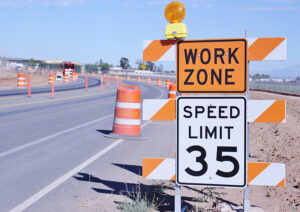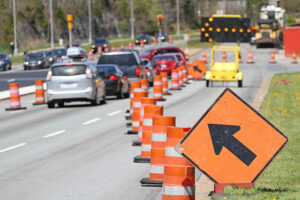Four Steps to Creating Safer Work Zones
By: Scott Fowler, ASSP Content Specialist

Creating a protective barrier between motorists and workers is an essential step. This enables workers to perform their tasks safely while motorists move about the roadway.
Roadway work zones are some of the busiest, and potentially most hazardous, work environments you can find, as workers perform tasks in close proximity to vehicles that are often traveling at high speeds.
According to the Federal Highway Administration, 842 work zone fatalities took place in the U.S. in 2019, an 11% increase over 2018. Furthermore, from 2010 to 2019, there were 1,249 construction worker fatalities at road construction sites according to the Center for Construction Research and Training.
From distracted driving to a lack of awareness of the work being performed, to motorists traveling at excessive speeds, work zone incidents are caused by a variety of reasons. With all of this in mind, contractors, safety professionals, workers, and others can take several steps to help prevent work zone incidents. In addition, emerging technologies can notify workers when a workplace intrusion has occurred. These four actions can help your organization improve highway work zone safety.
-
Develop a Traffic Control Plan
Protecting workers and motorists on roadways of any size requires an understanding of the regular traffic flow on a particular roadway and how construction activities will disrupt that flow. This forms the basis of the plan for how you will control traffic over the course of a construction project.
The recently updated ANSI/ASSP A10.47 standard, Work Zone Safety for Highway Construction, establishes requirements for construction and maintenance of highways and roads to help prevent injuries and fatalities through safe work practices, which includes developing a traffic control plan.
According to the standard, the project constructor should establish a traffic control plan for the entire work zone that addresses four key areas:
The advance warning area: This is the section of the highway where road users are informed about the upcoming work zone or incident area.
The transition area: In this section, road users are directed out of their normal path.
The activity area: This area is where work activity occurs. It is made up of the work space, the traffic space, and the buffer space.
The termination area: In this area, users return to their normal path.
-
Implement Protective Safety Measures

Protecting workers and motorists on roadways of any size requires an understanding of the regular traffic flow on a particular roadway and how construction activities will disrupt that flow.
Creating a protective barrier between motorists and workers is an essential step. This enables workers to perform their tasks safely while motorists move about the roadway. Based on the established traffic control plan, decision-makers must determine which barriers will best protect motorists and workers.
A10.47 states that positive protection measures need to be considered for each of these working conditions:
- Working zones that provide no means of escape (e.g., tunnels, bridges) from external motorized traffic intruding into the workspace
- Long duration work zones (e.g., two weeks or more) resulting in substantial employee exposure to motorized traffic
- Projects with high anticipated operating speeds (e.g., at least 45 mph or 72 km/h), especially when combined with high traffic volumes (more than 20,000 vehicles per day)
- Work operations that place employees within one-lane-width of travel lanes open to traffic
- Roadside hazards, such as drop-offs or unfinished bridge decks, that will remain in place overnight or longer
Protective measures take many forms, from electronic signage and arrow panels, to rumble strips and pavement markings. Depending on the project, one or a combination of these methods may help improve safety. Safety professionals working with these hazards and exposures should determine the most appropriate controls for a particular project based on site-specific circumstances.
-
Improve Worker Visibility
For motorists to operate safely around workers on the roadway, they must be aware of their presence. A10.47 states that all workers, including emergency responders, within the right-of-way who are exposed either to traffic (vehicles using the highway for purposes of travel) or to work vehicles and construction equipment within the work zone wear high-visibility safety apparel that meets the Performance Class 2 or 3 performance requirements of ANSI/ISEA 207.
This type of apparel takes on added importance in any nighttime construction work when overall visibility is diminished. A10.47 also explains illumination requirements to develop an illumination plan for night work so that workers are clearly visible, and to help control glare in such working situations.
Along with PPE, flaggers often play a major role in alerting motorists to the presence of workers, as well as controlling traffic flow through the use of hand signals, signs, or automated devices. A10.47 provides guidance on how to best employ and position flaggers, as well as how to ensure they are visible and have an escape path should an intrusion occur.
-
Use Intrusion Alert Technologies
The first three steps can help prevent workplace intrusions. However, when intrusions occur, workers need enough time to react and get to safety. That’s where work zone intrusion alert technology (WZIAT) comes in.
In the peer-reviewed article, “Work Zone Intrusion: Technology to Reduce Injuries & Fatalities,” published in the April 2018 issue of Professional Safety, Chukwuma Nnaji, John Gambatese, and Hyun Woo Lee examine different WZIAT technologies and discuss how they can alert workers of a work zone intrusion. Here are a few of the recent developments they highlight:
Intellicone
The Intellicone is much like a traditional safety cone in terms of design, with the notable exception that it includes a wireless audio-visual alarm system with audible tones of different pitches and oscillating cues. It features a portable site alarm and strobe lamps that are fitted onto safety cones and can communicate with one another. These devices can notify workers of a work zone intrusion up to 65 feet away.
Intellistrobe
The Intellistrobe offers both audio and visual alerts for work zone intrusions. The technology includes audio alerts, a gate arm signal light, and a pneumatic hose. An operator can control the unit from a safe distance. An audio alert is triggered when a vehicle pressurizes the hose.
SonoBlaster
A Sonoblaster is a carbon-dioxide-powered alert technology that is active when the traffic cone supporting the unit is tilted. One advantage of this device is that it can be attached to different types of barriers including cones, barrels and drums, security fences, barricades, and delineators. It also can determine the direction of an intruding vehicle.
Traffic Guard Worker Alert System
The Traffic Guard Worker Alert System is a pneumatic, trigger-based alarm system comprised of a lightweight visual-audio alarm unit, audio-vibratory personal safety device and a portable activation hose. The system transmits intrusion information via microwaves, whereby the pneumatic tube is placed along the cones and audio. Flashing lights and alerts are triggered when a vehicle compresses the tube.
The authors encourage manufacturers to ensure that future WZIAT produce sounds greater than 93 dB within 50 feet in addition to limiting false alarms. CS
Learn more about the widely adopted A10 voluntary consensus safety standards, and how they can help prevent worker injuries, illnesses, and fatalities at https://www.assp.org/standards/standards-topics/construction-and-demolition-operations-a10.



